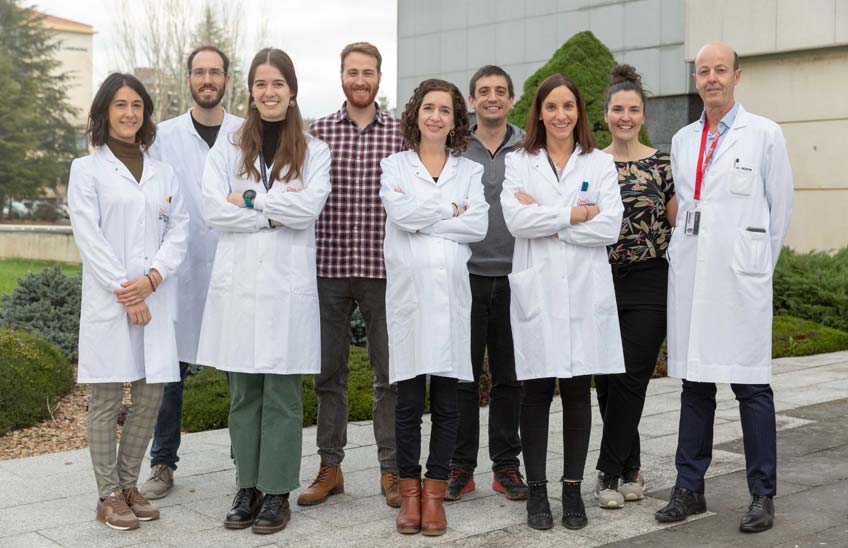Reversing a cause of age-associated blood cancers
Researchers from Cima and Clínica Universidad de Navarra identify an altered protein in patients with myelodysplastic syndrome that, when inhibited, restores the functionality of the blood cells involved in the disease.

FotoManuelCastells
/From left to right: Sarai Sarvide, Patxi San Martín, Nerea Berastegui, Guillermo Serrano, Teresa Esponda, Mikel Hernáez, Paula García, Amaia Vilas and Felipe Prósper, researchers in Hemato-Oncology at Cima and Clinical, who are part of the Cancer Center Clínica Universidad de Navarra.
21 | 02 | 2023
Researchers from the Cima and the Clínica Universidad de Navarra have analyzed how blood stem cells evolve in patients with myelodysplastic syndrome, a subject age-related blood cancer. In this analysis they have identified an altered protein that, when inhibited, restores the functionality of the blood cells responsible for the onset of the disease. This finding opens the door to the potential treatment of patients with this cancer subject that affects 16,959, according to the latest data of the Spanish group of Myelodysplastic Syndromes.
This work, carried out at framework of the Cancer Center Clínica Universidad de Navarra, is published in the scientific journal Nature Communications. Researchers from Queen Mary University of London, New York University, the Biobank of the University of Navarra, the CIC biomaGUNE, the Ikerbasque Foundation, the University Hospital of Salamanca-IBSAL and the Vall d'Hebron high school of Oncology have collaborated in it. Several of the researchers of this work belong to the research center Biomedica en network en Cáncer (CIBERONC) and the high school de research Sanitaria de Navarra (IdiSNA).
Replicating how blood stem cells mature
Myelodysplastic syndromes are a blood cancersubject in which the blood stem cells in the bone marrow (immature cells) do not produce enough healthy blood cells (white blood cells, red blood cells and platelets). This causes patients to have an accumulation of abnormal cells and a deficit of healthy cells that can lead to infections, anemia and bleeding. In one in three patients, this cancer progresses to acute myeloid leukemia, a much more aggressive hematological cancer.
Current treatments for myelodysplastic syndromes are scarce and of limited efficacy, so researchers are focused on understanding how the disease develops in order to design new therapeutic strategies. "Our group has studied for the first time the gene expression of blood stem cells in a group of patients with myelodysplasia. For that we have reproduced on the laboratory the maturation process of blood stem cells by comparing healthy samples with those of these patients. In the study of 57 donor samples (30 young donors, 8 adult donors and 19 patients with myelodysplasia), we have identified specific alterations of the disease other than those typical of aging," explains Nerea Berastegui, researcher at Cima and first author of article.
DDIT3, potential target for treating anemia
In this detailed analysis, they have also detected that patients with myelodysplasia have altered a protein involved in the training of red blood cells, a blood cell manager that transports oxygen through the body and whose deficiency is associated with the anemia typical of this cancer. "We have discovered that these patients have altered levels of the transcription factor DDIT3 in blood stem cells and that this alteration could be manager of the abnormal production of red blood cells (dyserythropoiesis)," says Teresa Ezponda, researcher at Cima and lead author of the study.
Combining artificial intelligence with flow cytometry and cutting-edge mass sequencing technologies, the researchers have succeeded in reversing this alteration and restoring normal production of these cells. "These results identify DDIT3 as a driver of dyserythropoiesis and a potential therapeutic target to restore the inefficient maturation process of blood stem cells to red blood cells, the cause of the anemia that characterizes patients with myelodysplastic syndrome. This finding allows us to go deeper into the knowledge of this disease and offers a possible therapeutic target that could be used to treat the anemia suffered by many of these patients", concludes Felipe Prósper, researcher of Cima and co-director of the Hematology Department of the Clínica Universidad de Navarra, also lead author of article.
This work has been supported by high school de Salud Carlos III, the Government of Navarra, La Caixa Foundation, Cancer Research UK, the Scientific Foundation of the AECC AIRC under the Accelerator Award Program, co-funded by FEDER 'A way of doing Europe', among other institutions.




